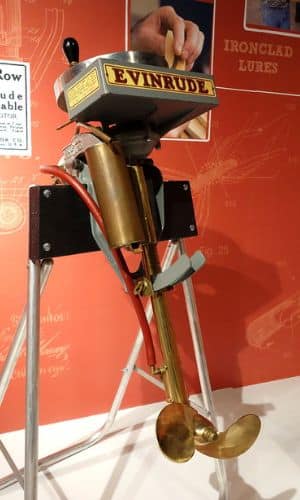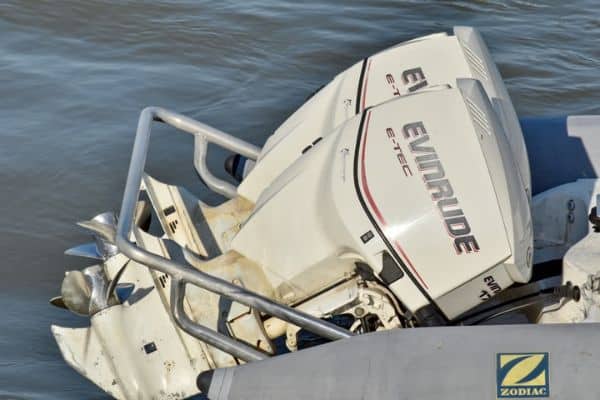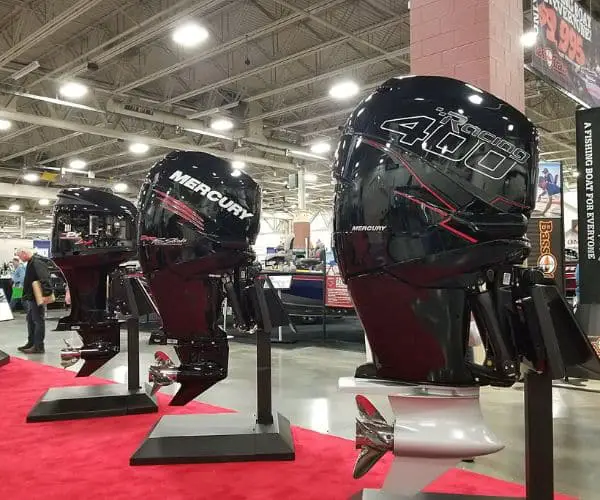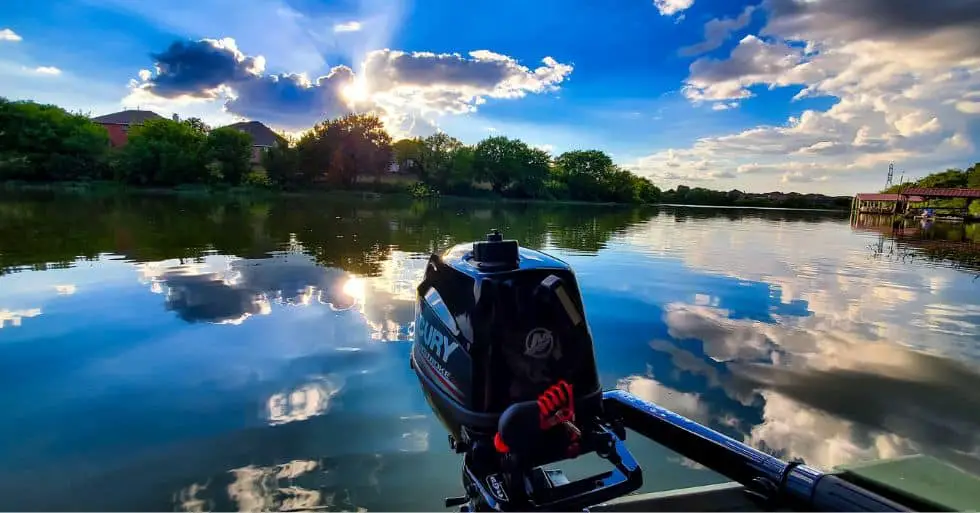Outboard motors are a common propulsion device used by boats of many sizes and styles. If you’re new to the world of boating, you may be wondering what an outboard motor is and if it’s the kind of motor that will best suit your boating needs.
An outboard motor is a self-contained engine unit used to propel a boat. Outboard motors are mounted to the transom of a vessel in the stern and can be steered from the unit or connected to a steering wheel, or helm in nautical terms.
Here is a diagram of some of the common parts on an outboard motor:

Even if you’re a new boater, chances are you’re already familiar with outboard motors. This is true if you’ve had any exposure to boating, even if your boating knowledge is limited. This is because outboard motors are very common for many recreational and commercial boats.
What makes outboard motors unique?

Related article: Inboard vs. Outboard Motor (Ultimate Comparison)
Think of outboards as motorized rudders. A rudder is the vertical and flat-shaped piece of material on the bottom part of a boat that’s used to steer. Rudders have been a component of boats for hundreds of years all the way back to the earliest seafaring vessels. An outboard motor is essentially a rudder that has a propellor connected to an engine.
Outboard motors serve the purpose of propelling and steering the boat, whereas inboard motors have the propellor and rudder as separate components. Additionally, while inboard motors are fixed, outboards can tilt the trim of the lower unit to help with running in shallow water and getting on plane easier.
Outboards are typically equipped with standard propellor blades, but some utilize a jet drive. Jet drive motors use the engine to force water through a strong water pump, which then thrusts the boat forward. Jet drive outboard motors are useful in shallow water areas, or areas with abundant hazards than can damage a standard propellor.
Outboard motors consist of a myriad of different parts, but to put it simply, they are comprised of:
- Powerhead – a.k.a. the engine. The powerhead houses many of the moving parts such as the cylinders, pistons, drive shaft, spark plugs, and many more parts.
- Mid-Section – the middle part of an outboard that contains the bracket that allows the motor to be mounted to a transom, as well as other parts such as the exhaust system.
- Lower unit – includes the propellor, water intake, and skeg (the lowest part).
Though you don’t have to be a mechanic to own an outboard motor, it certainly helps to know the basic components so you can identify possible problems and administer routine maintenance.
History of the outboard motor
Interestingly enough, outboard motors have been around for over 100 years. That’s a long time considering all the technological advancements over the last 100+ years. Still, with essentially the same motor design, many boats today use outboards to make them go.
The first commercially successful version of the outboard boat engine was invented by Ole Evinrude in 1909. The earliest version was a one-cylinder engine rated at a whopping 1.5 horsepower. If the name Evinrude sounds familiar, that’s because Evinrude Motors, founded by Ole Evinrude, had been an outboard company for years.

Since then, outboard motors have had many advancements to make them faster, more fuel efficient, run cleaner, and more lightweight.
What kind of boats use outboards?
Many types of boats use outboard motors, and odds are most of the recreational vessels you see on the water are using them.
Some common boats that use outboard motors are:
- Center console boats
- Bass boats
- Deep V boats
- Inflatable dinghies
- Skiffs
- Jon boats
- Sport catamaran racing boats
- Pontoon boats
Although outboard motors can be equipped with many different boat styles, they cannot be used for every type of boat. Especially large boats and specially designed boats like ski boats that use inboard engines for a variety of reasons. While outboards are very versatile, they’re not without their limitations.
What are the advantages of outboard motors?
There are many advantages to using an outboard motor. Most of all are the fact that they are more portable. Outboards can easily be swapped, taken off for storage purposes, or moved for maintenance. The same is not true for inboard motors that are a built-in component of the boat.
Other advantages of outboard motors include:
- Higher weight to horsepower ratio
- Less labor-intensive maintenance
- Better maneuverability
- Lower upfront cost
- Allows for extra interior space on the boat
- Higher potential top speeds
- Adjustable trim for shallow water
Though not suited for every boater’s needs, outboards have some serious advantages over other engine types. If these advantages are important to you, an outboard motorboat may be the best choice for you.

Are outboards better than inboard motors?
There is a never-ending debate between outboard vs. inboard boat engines. The truth is neither is perfect for every situation. Choosing between an inboard or outboard motor will depend on your intended use for your boat.
Inboard motors are better than outboard motors for:
- Watersports, such as wakeboarding and water skiing
- Larger boats because of higher torque
- Certain boat styles that cannot equip an outboard motor
As for outboard motors, they may be better for you due to:
- Varying depths or shallow water
- Lower budget
- Desire for easier maintenance
- Need for more interior space
Taking these things into consideration will allow you to make an educated choice for the type of boat that will ensure you’re getting out of it what you want. If you want an outboard motorboat, but you want to use it for water skiing, you may want to re-evaluate because, at the end of the day, it comes down to what type of motor will help you achieve your goals.
How much do outboard motors cost?
Outboard motors come in a variety of sizes and horsepower, but they can cost as little as a few hundred dollars for a well-used one, to over $100,000 for the latest high horsepower motors.
If you’re mechanically inclined and have the necessary tools, you can scour sites like eBay, craigslist, and Facebook Marketplace for used outboards at low prices. If you can get a used one working properly, you’ll have yourself an outboard without breaking the bank. Otherwise, expect to spend a hefty chuck of change for a brand-new motor.
The old-timers I’ve talked to tell me new outboards could be had for $75-$100 per horsepower or roughly $1000 per 10 horsepower. Well, unfortunately, that’s an oversimplification, and those days are long gone.
What it boils down to is in general, the higher the horsepower, the more you’ll have to spend, but the price per horsepower is less the higher the total horsepower of the engine. Think of it like buying in bulk, or at least that’s what you can tell the Mrs. when she asks why you bought the 150 horsepower instead of the 100 horsepower.
What are the best outboard motor brands?

There are many outboard motor manufacturers that make high-quality motors. With advancements in technology and a growing industry, outboard motors continue to improve on their overall performance year after year.
While every boater has their preference, some of the most popular and highly regarded outboard motor brands are:
- Yamaha
- Mercury
- Evinrude
- Suzuki
- Honda
Although those brands don’t represent all the outboard motor makers, many boats are sold with those engines because they’re industry leaders. You simply can’t go wrong with any of those brands, but with some experience and asking other boaters their opinion, you’ll soon find your favorite brand of outboard.
How fast can outboard motors go?
Outboard motors can move boats pretty fast, especially if equipped with multiple high horsepower motors.
Many of the more high-end center console boats can reach speeds of 60-80mph. That’s pretty fast if you ask me, and that’ll help you get to your fishing spot or to the local sandbar in no time.
Weight also plays a huge factor in determining speed, as even a low horsepower outboard like the one below can push a boat to 85 mph+ as long as it weighs little enough and has little drag.

According to Guinness World Records, the fastest speed achieved by an outboard motorboat is 176.556 mph by Bob Wartinger in 1989. That’s a little too fast for my tastes, but if you have a need for speed, today’s sport catamarans and outboards will definitely give you that adrenaline rush you’re looking for.
Conclusion
Outboard motors are a common and time-tested type of engine for boats of many styles and sizes. They have been around a long time, and it looks like they’re here to stay because of their versatility, easier maintenance, and portability.
With the different pros and cons we’ve outlined for outboard motors, hopefully, you’ll be able to decide if an outboard motor is right for you. Whether you want to race at blistering speeds, head out to your favorite fishing spot, or just take your family on a sunset cruise, there’s an outboard out there that’s perfect for you.
- What Is The Cheapest Way To Store A Boat? - February 28, 2023
- Do Boats Need Bottom Paint? (Uncovering the Truth) - February 2, 2023
- How Much Is Bass Boat Insurance? (Real Quotes) - January 18, 2023

